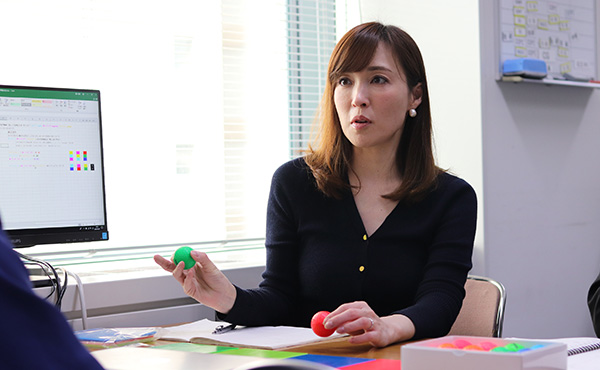Promoting the Development of DX-Related Human Resources, Data Utilization and Robotic Process Automation (RPA)
Kindness [Human Resource Development]
- E -
- S ●
- G -
Resource Reallocations Aimed at Achieving Fresh Growth
Sumitomo Rubber Industries has endeavored to make the performance of routine work tasks easier for employees through the introduction of operational systems and promoting Robotic Process Automation (RPA). Moreover, we are currently nurturing DX-related human resources capable of data utilization. At the same time, we are exhaustively reviewing our business process with an eye to achieving a drastic overhaul of backbone systems, even as we push ahead with operational streamlining and shift our focus to tasks that create higher added value.
Developing DX-Related Human Resources
We consider nurturing DX-related human resources essential in terms of “Laying Groundwork for Growing Lines of Business,” and “Expanding Growing Lines of Business,” both of which constitute pillars of the new Midterm Plan. Accordingly, we aim to ensure that all employees are equipped with the universal skills and mindset needed to realize a transition to a DX-driven business management approach and, to this end, initiated DX-related human resource training programs in October 2022, targeting all 3,500 administrative staff as part of resource reallocations. This will, in turn, help us achieve fresh growth.
In the below diagram we illustrate how we define three types of DX-related human resources. Building on the DX literacy education provided to all employees, we nurture “business core” human resources capable of promoting DX in ways that align with the types of business they handle; “professionals” capable of developing AI and conducting sophisticated data analysis; and “data engineers” capable of promoting measures to efficiently collect and utilize necessary data. As we aim to crystallize various DX measures by 2025, we will strive to complete the development of these human resources by that year to establish foundations that will facilitate the transition of the entire Sumitomo Rubber Group to data-driven decision making and action.
As of April 2023, 510 employees completed their DX literacy education. A further 100 “business core” trainees, 50 “professionals” and 61 “data engineers” also completed their training. Furthermore, we have incorporated hands-on training like Project Based Learning (PBL), through which employees, based on their actual duties, tackle subjects they have selected for themselves after receiving lecture-based education. This enables them to practice DX-driven problem-solving across 18 themes in diverse fields. In these and other ways, we aim to empower employees to utilize what they have learned in their daily operations.
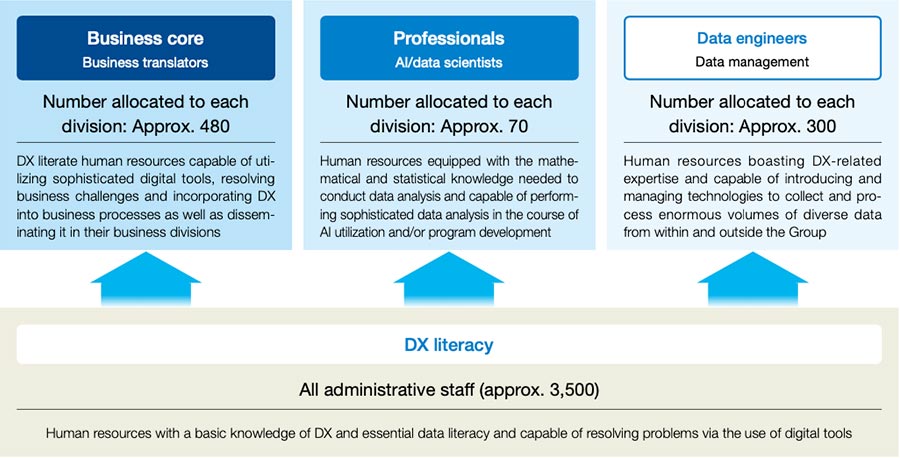
Fostering a Data-Driven Corporate Culture through the Promotion of Data Utilization Initiatives
We believe that the success of DX hinges on data utilization. Due to ongoing advances in digital technologies, we are now able to retrieve an ever broader range of data. In order for us to effectively utilize this data when determining our decisions and actions, it is essential that every one of our front-line employees has an awareness of the need to promote data utilization. To this end, we need to foster a culture supportive of data-driven operations throughout the organization.
To cultivate a data-driven corporate culture, in 2018 we introduced and have since promoted the utilization of “Tableau,” a business intelligence (BI) tool designed to empower users to visualize and analyze data for themselves. This tool is currently being used by approximately 4,200 employees on a global basis. We expect that its utilization will yield three benefits: (1) the streamlining and automation of operations, (2) the acquisition of fresh insights arising from data visualization and (3) smoother collaboration via the swift sharing of new findings.
With regard to (1), we have seen a number of instances in which employees have been able to shorten the time spent on particular tasks or to automate such tasks (e.g., immediate confirmation of needed information) by shifting from manual data collection and calculation to the automated data collection and visualization enabled by Tableau.
As for (2), by allowing the examination of long-term data, which had previously not been taken into account, and the combination of multiple data sets, Tableau has made it possible for us to acquire a number of fresh insights. Moreover, Tableau’s functions include the generation of reports and dashboards that can be quickly shared among users. This, in turn, helps promote collaboration as mentioned in (3) above in various aspects of business operations.
As we aim to ensure that all employees enjoy these benefits, we continually strive to develop an environment that enables them to utilize this tool with confidence. In particular, we are putting an emphasis on Tableau-related education and community building (connection between employees). To this end, we have developed unique educational programs so that employees can learn how to use Tableau from in-house sources while periodically hosting study sessions with lectures presented by specialist employees. Furthermore, we hold “Tableau Day,” an in-house event aimed at building communities, as part of initiatives to help employees learn about diverse best practices within and outside the Group and raise their ability to utilize Tableau going forward.
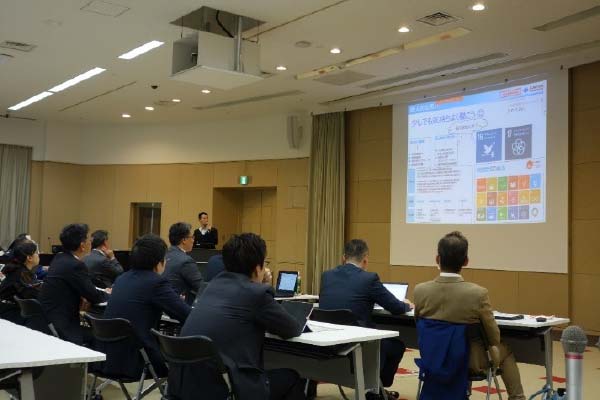
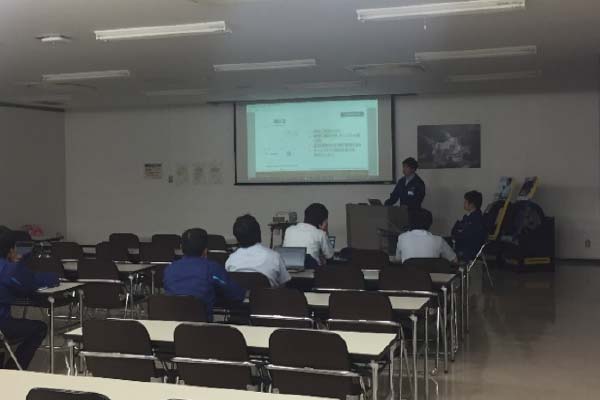
An in-house study session (above) and a “Tableau Day” event (below)
Looking ahead, we aim to further promote the use of Tableau by encouraging each department to utilize it and securing data coordination across the Company, with the aim of realizing the overall optimization of data utilization. By doing so, we will empower each employee to undertake data-driven decision making at an even faster pace and thereby contribute to operating results even as we provide them with a more worker-friendly environment.
An Example of Tableau Utilization
The use of Tableau enabled us to relieve employees from a workload equivalent to a total of more than 100,000 hours on an annual basis. Among a number of instances of successful utilization, we showcase one best practice achieved by manufacturing front lines.
Previously, employees on manufacturing front lines had to acquire diverse data, for example, on production output results, from various systems and manually input and aggregate this data using Microsoft Excel. As the aggregated data needs to be presented every day at a morning meeting, individuals charged with data aggregation had struggled to complete this task in a limited time, and there had also been a risk of data input error.
To improve this situation, Tableau was introduced and connected with existing systems. Doing so made it possible to automatically view all necessary information. In addition, Tableau screen layouts can be adjusted to focus on the viewer’s desired area of data analysis. Thus, the employees using it are now able to immediately acquire the exact type of insight they require. While the use of Tableau resulted in operational streamlining, the tool also helped transform the way daily meetings that utilize various data are conducted. Previously, a large portion of meeting time had been accounted for by reporting on production output results; now, however, meeting attendees are able to allocate more time to discuss actions to be taken in response to such results as data compiled by Tableau is readily available to all of them.
Promoting RPA
- The Sumitomo Rubber Group
Sumitomo Rubber Industries promotes RPA for two reasons. We consider RPA to be an essential approach to (1) enabling digital-driven business management while (2) improving employee experience.
With regard to (1), we believe that the RPA-based restructuring of our business operations (ranging from product planning, manufacturing and maintenance to sales) is essential to digital-driven business management. To this end, we aim to push ahead with the upgrading of our business platforms, especially those related to routine work, through automation or rectification (via process standardization and rule formulation).
As for (2), we not only intend to reduce working hours but also strive to enhance the quality of labor. In this context, we have positioned RPA as a central component of workstyle reforms.
Having concluded that the introduction of RPA is necessary based on these two reasons, our administrative departments have promoted the RPA of five types of operations since April 2018. They have also launched the assessment of results and the verification of value created by RPA.
As the abovementioned RPA initiatives have attracted an immense interest among employees, we newly established the “RPA Promotion Office” under the Human Resources & General Affairs Department in April 2019 with the aim of expanding the scope of operations subject to RPA. This organization was renamed the RPA Promotion Group and is currently placed under the General Affairs Department of the Human Resources & General Affairs HQ. The RPA Promotion Group not only promotes the automation of existing operations but also provides proposals on RPA-based solutions, including for the streamlining of operational flows and the renovation of existing systems, as well as assistance in implementing such proposals.
In 2020, we began promoting the employee-driven development of RPA with the aim of accelerating the spread of RPA within the workforce. To this end, we provide employees with training on RPA development to instill the skills necessary to handle RPA as well as for streamlining their operations. We are thus endeavoring to help each employee feel the tangible benefit of operational streamlining and skill enhancement while enabling them to transition to more sophisticated functions. In these ways, we strive to improve employee experience.
An Example of RPA
- The Sumitomo Rubber Group
As of May 31, 2023, we have introduced approximately 590 robots for RPA. These robots have enabled an annual reduction in the total employee workload equivalent to approximately 66,400 hours.
Among many cases of successful RPA, the automatic collection and calculation of data used for the analysis of how a ball flies, an essential process of golf ball development, particularly contributed to the enhancement of employee experience. Previously, employees had spent a total of 50 hours each month compiling charts and creating graphs tracking a huge volume of wide-ranging numerical data, including data obtained via machine-based measurement or converted from inputs from human players regarding how they felt when hitting the ball. However, the introduction of RPA made it possible to automatically compile all the necessary numerical data into charts and graphs with a single click. As a result, the same process of data collection and calculation now requires a monthly total of only 12 hours. Moreover, this relieved the employees involved in crunching the data from the psychological burden of needing to meet the data compilation deadline and freed them to play a broader range of roles in product development, including tasks they previously were unable to undertake when they were preoccupied with data analysis.
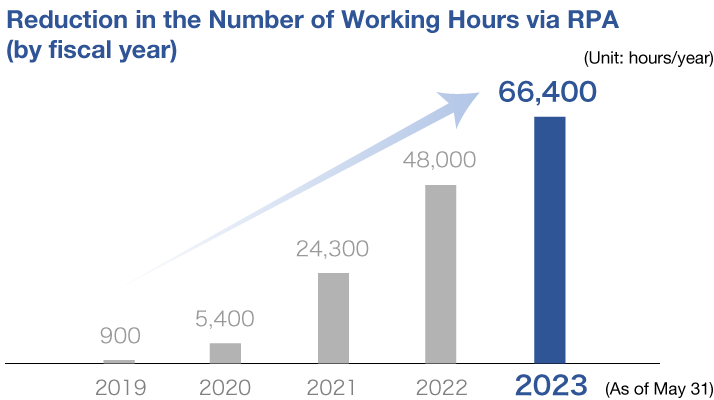
The RPA Promotion Group’s vision is to continuously provide an experience of change.
This business unit has identified five elements supporting the realization of the abovementioned vision. These elements are “creating opportunities to discover what is taken for granted based solely on preconceived ideas,” “identifying and resolving unreasonable or inconsistent data,” “facilitating connections among employees, departments and systems,” “reducing the sense of burden” and “generating capacity and capability.” By providing employees with a positive experience of change, we will strengthen internal operational platforms as well as invigorate a workplace culture of innovation.
